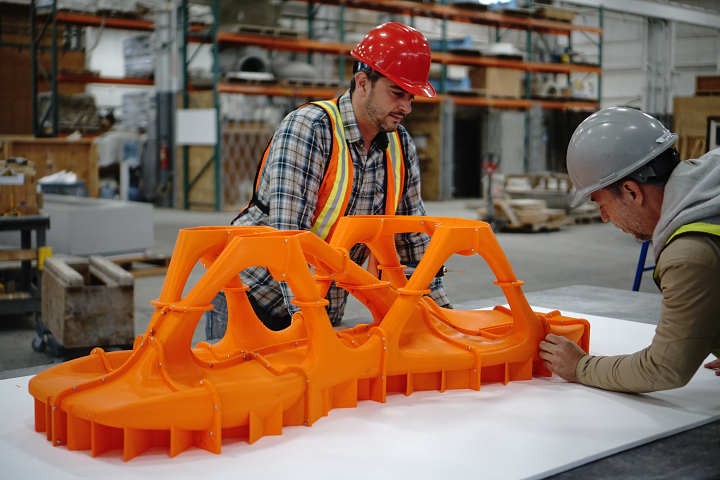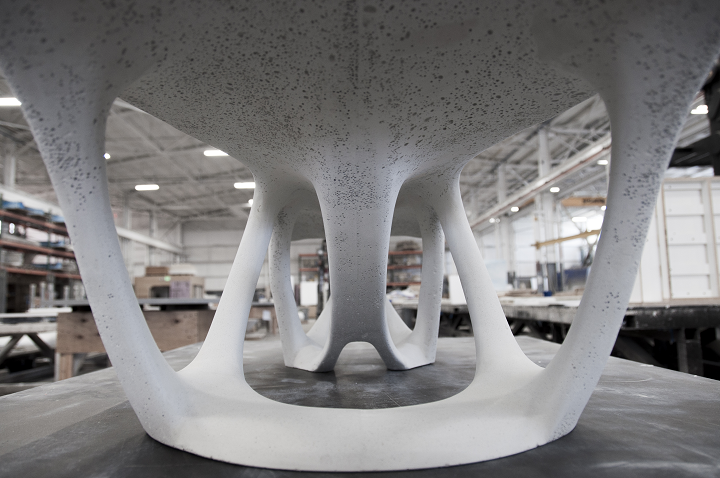There are countless applications for products and parts made with 3D printed molds, such as prosthetic aligners, microneedles and organ-on-a-chip devices, and even building restoration. Experimental design studio Slicelab, remotely based out of Denver and New York, specializes in digital fabrication, and offers design services in architecture and product/furniture design. Founded in 2012 by Arthur Azoulai and Diego Taccioli, the studio says that it operates “between the disciplines of art and architecture,” and has recently been researching the use of 3D printing in fabricating molds for complex concrete forms. This work resulted in a truly lovely piece of furniture called the Delicate Density Table.
Slicelab was attracted to 3D printing for this project because the technology has fewer limitations in terms of cost and time to design and create complex forms.
“A concrete exploration using 3D printed molds with a goal to see how delicate, detailed, and finite concrete can get while still being structurally rigid,” the studio wrote. “Using 3D printing as a new way to realize concrete through its ability to make molds, we have been interested in pushing the concretes’ natural limitation through fine geometries.”
Concrete features a very compressive strength, but is more brittle when it’s used to create shapes with fine geometries that create a lot of tension loads. Additionally, the material also has the unique ability to take on any shape, while 3D printing has the ability to create complex geometries, and Slicelab saw the potential in combining the two to create a piece of furniture that had both density in material and a delicate form, while still maintaining the strength of the concrete. The studio partnered with Concreteworks and Hummingbird 3D for this project, which resulted in multiple unique molds that were then put together and used to make an 86 kg white concrete table with 152.5 x 45.5 x 38 cm dimensions.
The studio figured out the overall structure of the model ahead of time, through the use of digital simulation and optimization. This is when they realized that, due to the size of the table design and the build volume constraints of the LulzBot TAZ 3D printers they would be using, they would need to break the model down into 23 separate pieces.
Each of the 23 parts were oriented and optimized in a certain order so the least amount of supports would have to be used, which would help speed up assembly. The pieces were 3D printed out of recycled PLA, and then fastened together to make a single 5 ft. investment mold, which weighed about 66 lbs and was able to hold up under 200 lbs of non-reinforced super high-performance concrete.
“The order of which the pieces were assembled played a huge roll in how well the pieces aggregated together,” Slicelab explained. “Even with absolute printing precision, the plastic can crack, warp and often create uneven surfaces that require a lot of post-process work to fully function as a watertight mold for concrete especially when put onto a vibration surface.”
The team created the mold with a built-in, leveled diamond platform on top, so it could be positioned upside down and flat when the concrete was poured inside, to ensure that most air bubbles would be on the bottom of the table and not visible from the top. This reinforcing platform also helped to keep the center of gravity low during pouring, and was also designed to be the only part released from the concrete in a single piece. Speaking of pouring concrete, the voids at the bottom of the mold were used to pour concrete into three major access points, down through the ten legs, and into the main cavity of the bench.
Once the concrete had completely cured inside, the mold was literally broken off piece by piece to reveal the final Delicate Density Table. Slicelab then used diamond pad wet sanding to get a mirror-like finish, which also really emphasized the fluid form of the top of the table—a major contrast to the porous texturing on the table legs.
Since we’re all about sustainability here in the AM industry, it’s nice to know that the team also saved as many of the broken pieces of the mold as possible, so they can be used at a later date for a different project.
(Source/Images: Slicelab)
Subscribe to Our Email Newsletter
Stay up-to-date on all the latest news from the 3D printing industry and receive information and offers from third party vendors.
Print Services
Upload your 3D Models and get them printed quickly and efficiently.
You May Also Like
The Dental Additive Manufacturing Market Could Nearly Double by 2033, According to AM Research
According to an AM Research report from 2024, the medical device industry, specifically in dentistry, prosthetics, and audiology, is expected to see significant growth as these segments continue to benefit from...
Heating Up: 3D Systems’ Scott Green Discusses 3D Printing’s Potential in the Data Center Industry
The relentless rise of NVIDIA, the steadily increasing pledges of major private and public investments in national infrastructure projects around the world, and the general cultural obsession with AI have...
AM Research Webinar Explores Continuum’s Sustainable Metal Additive Manufacturing Powders
Metal additive manufacturing (AM) powder supplier Continuum Powders is working to develop solutions that empower industries to reduce waste and optimize their resources. An independent life cycle assessment (LCA) of...
3D Printed Footwear Startup Koobz Lands $7.2M in Seed Round
California-based Koobz is focused on reshoring the U.S. footwear supply chain with advanced manufacturing processes, including 3D printing. The startup just announced that it has added $6 million to its...





































